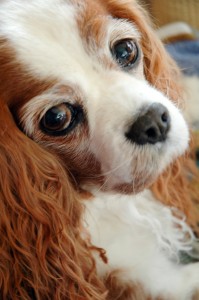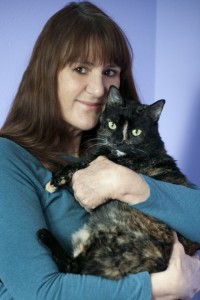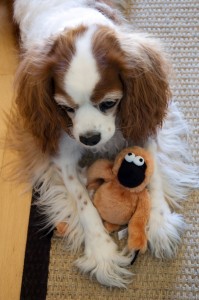 This week I had one of those “double-edged sword” days in my work. When I ask myself why I do what I do, and know I wouldn’t do anything else.
This week I had one of those “double-edged sword” days in my work. When I ask myself why I do what I do, and know I wouldn’t do anything else.
On an almost daily basis I place myself squarely in the face of grief and loss. No, I’m not a minister or health care provider: I’m an intuitive and spiritual consultant, and right now I’m talking about animal communication.
Early in the morning I had a phone call. The woman had barely started to talk, asking those polite things we do, “I emailed, but I decided to call, too,” when I heard it in her voice: death was knocking at her door.
Turns out, she and her husband lived with an aged Alaskan malamute, and, while the dog had been up and down all year, it seemed like down was permanent. She asked me to talk with her dog and find out: are you ready to go, is it time, do you want help, what can I do for you?
Sometimes these calls fall into the “emergency” category, as this one did. So the appointment isn’t scheduled, it’s on top of me, with no time to prepare and a serious issue to confront. What I learned and conveyed would make a difference to these two soul mates—a woman and a dog who loved each other.
Yes, there are many intuitives who won’t take these calls, whether it’s an ill or dying animal or a lost one. The pressure is intense and can be debilitating without a lot of self-awareness, self-care, and boundaries. It’s taken me a lot of time to learn this, as both a woman in a patriarchal culture and an intuitive in a skeptical one, so I took a deep breath and did what I had to do: I asked some questions to clarify the situation, and said I’d talk with the dog and call the woman back in an hour. And then I had a quick breakfast, to get myself ready for the day, and spent some time quietly chatting with the dog, who I’ll call Clem, while energetically scanning her body to get as much information as possible.
Clem fell into the “I could go or I could stay” category. She was clearly dying: she wasn’t in any pain, but old age was slowly claiming her as her body was shutting down. She felt she could die on her own, but would like some help, and “now today” worked for her. Or she could simply “walk the mystery,” as my beloved dog, Murphy, did, as she explored the dying process with me by her side, if her person didn’t want the pressure of choosing euthanasia.
As someone who loves my animal family, I can honestly say that “now today” is something you never want to hear. I can also say that I’ve honored my family’s wishes, and, with clients, I carefully explain the options. Those who are truly living the human-animal bond seriously consider their animal’s wishes. Because love matters.
Turns out, the woman wasn’t surprised by this. She had watched her dog slowly wind down for some months, and intuitively felt the time was ready. Her dog simply confirmed it, while also giving the woman the final choice: she could help her dog out that day, or she could stick with her until she died on her own or until she started to suffer.
The woman was both saddened and relieved to hear this. Knowing her dog wasn’t suffering gave her some time. I suggested that she not make an immediate decision, but simply spend the day with her dog, even make a ritual of the dying process. Our culture today tends to ignore death, but by recognizing and honoring it, we can bring beauty, comfort, and closure to a relationship, which helps in the moment and later, when only ashes remain.
I checked in with her later that day. By then it was clear to her that her dog was more than ready, there was no more doubt that it was time, and they’d had a beautiful last day together. Because I work with my dad, who’s in the afterlife and cares for the newly transitioned (another story, another time), I could monitor the process and know when Clem died and moved on.
The next day I was deeply touched to receive an email from my client saying that she’d “felt my love” all day. Yes, love matters.
Living the Human-Animal Bond
 Sometimes what animals say to us is surprising. I remember when a very ill cat told me he wanted to die: he really didn’t, as I could tell from his nuanced conversation (yes, you can pick up nuances telepathically), he really wanted to know what was wrong with him, what his person was doing about it, and what it would mean. Would he recover and be fine, or drag on and be miserable? Sadly, his person ignored the answers I offered, and, while the cat recovered, his journey to wellness would have been easier on both of them if his person had simply backed me up by explaining things. I learned from that to be careful who I worked with—because the human-animal bond as I live it, at home and at work, means that we listen to our animals, respond to them as intelligent equals, and bumble our way through life, together.
Sometimes what animals say to us is surprising. I remember when a very ill cat told me he wanted to die: he really didn’t, as I could tell from his nuanced conversation (yes, you can pick up nuances telepathically), he really wanted to know what was wrong with him, what his person was doing about it, and what it would mean. Would he recover and be fine, or drag on and be miserable? Sadly, his person ignored the answers I offered, and, while the cat recovered, his journey to wellness would have been easier on both of them if his person had simply backed me up by explaining things. I learned from that to be careful who I worked with—because the human-animal bond as I live it, at home and at work, means that we listen to our animals, respond to them as intelligent equals, and bumble our way through life, together.
While Clem’s case ended in death, it also perfectly illustrated our lives with animals.
The human-animal bond is important to me: creating families with animals has been a major feature of my life for the last eighteen years. While I had “pets” throughout childhood, and in particular a beloved English Cocker spaniel for ten years, it wasn’t until 1998 that I consciously created a family with dogs, and, eventually, a cat (better known as our resident alien). As my relationship with my two Cavalier King Charles spaniels and the cat deepened, I “learned up” with my animal family. By that I mean I recognized that our life together was one of equals, regardless of species, that it didn’t matter that they were animals and I’m human, because the soul bond between us is there.
These days, many of us are proud to claim our animals as family members, whether we live alone with them, as I do, or other humans are involved. Living our lives with animals as family (what I call “multi-species families”) enriches us beyond anything most of us ever imagined, and, of course, adds strange complications and annoyances. I drive the car and buy the food, and my animals, well, they learn to live in a world geared towards humans, which isn’t easy for them, even for dogs like mine, which are bred to do exactly that. My life isn’t college costs or “sex and drugs” talk: it’s poop bags and leash training and finding a way to communicate when English isn’t their first language.
In this brave world of the human-animal bond, we and our animal families have learned up from ancient necessity that brought wolves to our nomadic camps to heart and soul growth in our modern comfy neighborhoods. It makes for strange and fascinating lives—and the heartache of loss as terrible as it is when we lose humans, even worse if family and friends don’t understand and support us.
But on that day, when a woman and a dog said goodbye to each other, that was a day to celebrate. Because someone loved her dog and lost her. Because she and her dog did everything right. Because I could provide some small comfort in the process.
We always hate to see them go—grief hurts. We can also always celebrate the bond—because grief means we loved and were loved.
And love matters.
Yes, it hurts sometimes, but that’s why I do what I do. Because once in a while I can be there at a crucial moment in the life of a multi-species family. Because I can help. Because I can bear witness to what really matters in our busy, mixed-up, noisy world.
Love.
© 2016 Robyn M Fritz
 mals and the Afterlife
mals and the Afterlife People debate reincarnation, multiple simultaneous lives, whether humans can be reborn as animals (or vice versa)—even whether animals can reincarnate. Others like me live with the truth: souls can do whatever they want, regardless of human dogma. Souls choose the form they need to do the job they chose before they incarnated, and if everything works out, they succeed. As we all know, though, once bodies, free will, and real life interact, it’s a free-for-all, anything-can-happen world.
People debate reincarnation, multiple simultaneous lives, whether humans can be reborn as animals (or vice versa)—even whether animals can reincarnate. Others like me live with the truth: souls can do whatever they want, regardless of human dogma. Souls choose the form they need to do the job they chose before they incarnated, and if everything works out, they succeed. As we all know, though, once bodies, free will, and real life interact, it’s a free-for-all, anything-can-happen world. Murphy wasted no time dismantling everything I thought I knew about the world (which turned out to be a good thing). She was six months old when I noticed that her nuanced responses to people, animals, and the world around her were far beyond what we consider to be animal intelligence. The rest of it is the earthquake’s fault. On February 28, 2001, Murphy was curling up for a nap when she leaped up barking and snarling and dragged us out of our condo—about two minutes before Seattle was rocked by a 6.8 earthquake.
Murphy wasted no time dismantling everything I thought I knew about the world (which turned out to be a good thing). She was six months old when I noticed that her nuanced responses to people, animals, and the world around her were far beyond what we consider to be animal intelligence. The rest of it is the earthquake’s fault. On February 28, 2001, Murphy was curling up for a nap when she leaped up barking and snarling and dragged us out of our condo—about two minutes before Seattle was rocked by a 6.8 earthquake. Alki Fritz, Dec. 25, 2001 – Nov. 17, 2014.
Alki Fritz, Dec. 25, 2001 – Nov. 17, 2014. Do you ever wonder why you bother? Not just to get up, but to stay up when you know that mostly what you’ll get is hurt?
Do you ever wonder why you bother? Not just to get up, but to stay up when you know that mostly what you’ll get is hurt? I’m sharing this rambling note with you so you know that darkness comes to all of us, no matter how much we love, because in choosing to incarnate here we choose to experience organic life, and that means it will eventually end. But darkness doesn’t have to destroy us: we can choose how we meet it. Have you ever felt grief, worry, doubt, confusion, despair? Of course you have, because you are here. You are not alone. We all have something we have to deal with, like it or not, because we all bothered to love. It matters.
I’m sharing this rambling note with you so you know that darkness comes to all of us, no matter how much we love, because in choosing to incarnate here we choose to experience organic life, and that means it will eventually end. But darkness doesn’t have to destroy us: we can choose how we meet it. Have you ever felt grief, worry, doubt, confusion, despair? Of course you have, because you are here. You are not alone. We all have something we have to deal with, like it or not, because we all bothered to love. It matters.
 This spring I was privileged to attend the death of a dear friend’s beloved cat, Sachi, who had terminal cancer and had reached the end of what she could tolerate. My friend, Reiki master and massage therapist Mary Van de Ven, had done everything possible to help Sachi, but the cancer was relentless.
This spring I was privileged to attend the death of a dear friend’s beloved cat, Sachi, who had terminal cancer and had reached the end of what she could tolerate. My friend, Reiki master and massage therapist Mary Van de Ven, had done everything possible to help Sachi, but the cancer was relentless. Oh, the best laid plans. The next morning it was pouring down rain and I got lost. As I was driving, my dad suddenly popped in.
Oh, the best laid plans. The next morning it was pouring down rain and I got lost. As I was driving, my dad suddenly popped in. Nearly every week for the last two years I’ve received emails thanking me for the article I wrote about taking my beloved Murphy to the veterinary surgeon to discuss treating the cancer that would inevitably kill her. Most of these emails are private; many are also here on the blog
Nearly every week for the last two years I’ve received emails thanking me for the article I wrote about taking my beloved Murphy to the veterinary surgeon to discuss treating the cancer that would inevitably kill her. Most of these emails are private; many are also here on the blog 
 It wasn’t. It was me listening to crappy vets—me being away from dogs for a dozen years and overwhelmed by the new world of animal care. It was me agreeing to bad food, repeated vaccinations, paternal dogma, and early spay/neuter.
It wasn’t. It was me listening to crappy vets—me being away from dogs for a dozen years and overwhelmed by the new world of animal care. It was me agreeing to bad food, repeated vaccinations, paternal dogma, and early spay/neuter. Remember those conversations I’ve had with people in the last year? I quietly explain to them that I lost my oldest dog to cancer. Their eyes fill up, they express condolences, and then I quietly say, “Did you know that cancer is linked to early spay/neuter?”
Remember those conversations I’ve had with people in the last year? I quietly explain to them that I lost my oldest dog to cancer. Their eyes fill up, they express condolences, and then I quietly say, “Did you know that cancer is linked to early spay/neuter?” Love will lead the way.
Love will lead the way.


 Our animal families matter, and so do our kids. Here is Alki, recovering from a severe illness, if you ever recover from inflammatory bowel disease and pancreatitis, let alone long-term kidney disease. We remember that age doesn’t always bring illness, but when it does it also reminds us that we have lived a long life, and we’re still determined to make it a fun one! Here’s Alki reminding Grace that this is HIS get well card, and then wondering why he can’t eat it. Shyness is cute! Thank you to Cyndi O-neill Dady and SendOut Cards!
Our animal families matter, and so do our kids. Here is Alki, recovering from a severe illness, if you ever recover from inflammatory bowel disease and pancreatitis, let alone long-term kidney disease. We remember that age doesn’t always bring illness, but when it does it also reminds us that we have lived a long life, and we’re still determined to make it a fun one! Here’s Alki reminding Grace that this is HIS get well card, and then wondering why he can’t eat it. Shyness is cute! Thank you to Cyndi O-neill Dady and SendOut Cards!





















